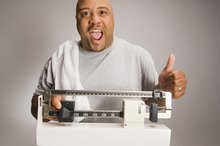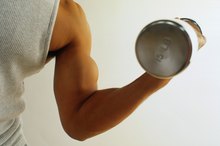What is a Good Deadlift, Squat and Bench Press?
If you had to pick just three exercises to perform, you wouldn't go wrong with deadlifts, squats and bench presses.
These are the three powerlifting competition exercises, but are also highly effective for building total-body strength and muscle mass and increasing sports performance. Deadlifts mainly work your hamstrings, glutes, abdominals and spinal erector, lat and rhomboid muscles of your back. Squats work your quads, hamstrings, abs, lower-back and calves. Bench presses get the pec muscles of your chest, the triceps on the back of your arms and your shoulders. For a lift to be considered good, it must meet required one-repetition max standards.
A one-rep max is the maximum amount of weight you can lift with perfect form. Set yourself a goal of achieving good-strength standards across all three lifts.
Men's Strength Standards
In "Starting Strength," weightlifting coach Mark Rippetoe lays out his basic strength guidelines for men according to body weight. A novice male lifter at a bodyweight of 165 pounds should be able to deadlift at least 254 pounds, squat 204 pounds and bench press 152 pounds. An intermediate-level lifter at the same body weight should be able to deadlift at least 293 pounds, squat 250 pounds and bench press 201 pounds. For an advanced-level lifter these rise to 411 pounds, 342 pounds and 255 pounds. As your body weight increases so should your lifts. A 242 pound novice-level lifter should be able to deadlift at least 318 pounds, squat 255 pounds and bench press 190 pounds.
An intermediate-level lifter should be able to deadlift 363 pounds, squat 311 pounds and bench press 232 pounds, while an advanced lifter at this body weight should get a 490-pound deadlift, a 423-pound squat and a 316-pound bench press. In "Brawn," trainer Stuart McRobert adds that another target all men should aim for is a 300-pound bench press, 400-pound squat and 500-pound deadlift.
- In "Starting Strength," weightlifting coach Mark Rippetoe lays out his basic strength guidelines for men according to body weight.
- An intermediate-level lifter at the same body weight should be able to deadlift at least 293 pounds, squat 250 pounds and bench press 201 pounds.
Women's Strength Standards
Male Average Pulse With Treadmill Exercise
Learn More
Similar standards apply to women, with novice-level deadlift, squat and bench numbers starting at 105 pounds, 84 pounds and 63 pounds for a 97-pound lifter; rising to 122 pounds, 98 pounds and 73 pounds for an intermediate-level lifter; and 175, 129 and 94 pounds at advanced level. Like the men's guidelines, these standards increase as body weight goes up.
For guidelines similar to McRobert's, trainer Adam Farrah recommends women shoot for a 275 to 350-pound deadlift, a 220 to 280-pound squat and a 165 to 210-pound bench press. These are more ambitious, but Farrah recommends using them as a guide, rather than taking them as gospel.
- Similar standards apply to women, with novice-level deadlift, squat and bench numbers starting at 105 pounds, 84 pounds and 63 pounds for a 97-pound lifter; rising to 122 pounds, 98 pounds and 73 pounds for an intermediate-level lifter; and 175, 129 and 94 pounds at advanced level.
- For guidelines similar to McRobert's, trainer Adam Farrah recommends women shoot for a 275 to 350-pound deadlift, a 220 to 280-pound squat and a 165 to 210-pound bench press.
Safety Considerations
These guidelines are all based around one-rep maxes -- the heaviest weight you can lift with good form for one rep. Finding your one-rep max is a relatively simple process, though it can be risky. Complete a thorough warm-up, along with plenty of light sets on the exercise you're testing, advises strength coach Sally Moss. When you're warmed up, start performing single reps with a moderately-challenging weight, adding weight to the bar every set. When you reach the point that you can't complete a rep with good form, you've found your one-rep max. Always have at least one spotter or training partner present when testing your max to ensure your safety.
Once you know your one-rep max, you can use the strength standards as a goal to aim for.
Base your training off your one-rep max number. To build strength, perform between three and eight reps per set using between 70 and 95 percent of your one-rep max.
- These guidelines are all based around one-rep maxes -- the heaviest weight you can lift with good form for one rep. Once you know your one-rep max, you can use the strength standards as a goal to aim for.
Varying Repetition Ranges
How to Lose 25 Pounds & Tone Up in 3 Months
Learn More
Strength doesn't necessarily just refer to single-repetition maximums. While very low rep training does have benefits, particularly for powerlifters, weightlifters and athletes, it has little carryover if you're looking to increase your fitness or lose fat.
Rather than aiming for a specific one-rep max target, simply aim to add weight to the bar gradually in whatever rep range you're training in. Aiming to add just 2 1/2 pounds each workout, or adding an extra rep per set each time, you will ensure steady, consistent progress.
Sets of one to five reps build strength, sets of six to 12 are best for muscle mass and higher-rep sets increase your muscular endurance. Use strength standards as a guideline, but concentrate on your own progress by making sure you get a little better each session.
- Strength doesn't necessarily just refer to single-repetition maximums.
- While very low rep training does have benefits, particularly for powerlifters, weightlifters and athletes, it has little carryover if you're looking to increase your fitness or lose fat.
Related Articles
References
- CrossFit: Basic Strength Standards
- Brawn; Stuart McRobert; April 2007
- Gubernatrix: Testing Your One Rep Max
Writer Bio
Mike Samuels started writing for his own fitness website and local publications in 2008. He graduated from Peter Symonds College in the UK with A Levels in law, business and sports science, and is a fully qualified personal trainer, sports massage therapist and corrective exercise specialist with accreditations from Premier Global International.








